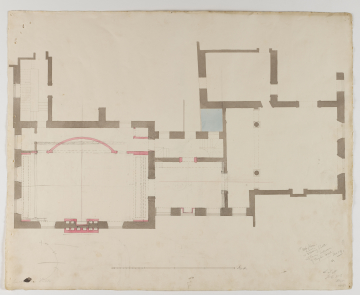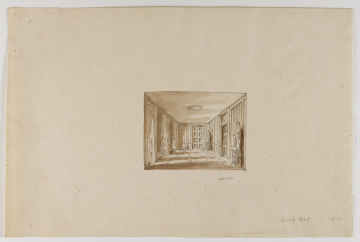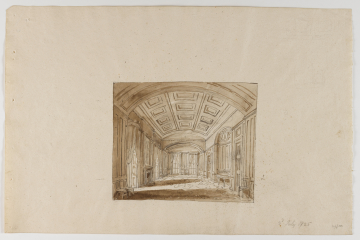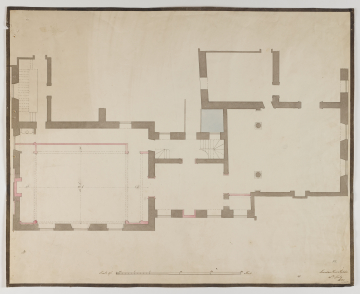
Browse
Reference number
Purpose
Aspect
7 Part plan of the first floor
8 Part plan of the first floor
9 Interior perspective of Anti Room (sic)
10 Interior perspective of State Dining Room
11 Part plan of the first floor
Scale
Inscribed
7 labelled: (feint pencil) Lincolns Inn Fields, Anti (sic), (added later in pencil by Walter L. Spiers, 1848-1917, curator 1904-17) 1st Top floor / 10 Downing Street / replaces bedrooms / of Taylor's Work / See 19
8 labelled: Flat Ceiling / 15.0 high, 26.9, Ceiling as it was before / as to height
9 as above (added later in pencil by Walter L. Spiers, 1848-1917, curator 1904-17)
11 labelled: 4.6, 23.6, 30.9, 2.3, 6.9
Signed and dated
- (6, 8) Lincolns Inn Fields / 2nd July 1825 (7) L. I. F. / July 2nd / 1825 (9) 2 July 1825 (10) 2d July 1825 (11) Lincolns Inn Fields / 4th July / 1825
Medium and dimensions
Hand
Watermark
Notes
'The new ante-room was all windows and doors, with no room for a chimneypiece, forcing Soane to add one under the central window (drawn freehand over the plan) (drawing 6). This would result in the tricky diversion of the chimney flue either side of the window. In the larger dining-room, some rough lines on Soane's plan (drawing 6) at the end of the room begin to suggest that the loss or alteration of one of the three large side windows could be avoided if the new fireplace was located on the end wall facing the central axis.' Symmetry along the enfilade between the two rooms was not possible as the shape of the rooms was forced by the need to retain the existing service corridor and water closet along the west side (P. Dean, Sir John Soane and London, 2006, p. 114).
Two interior perspectives (drawings 9 and 10) show the proposed ante-room with panelled walls and the new dining room as in drawings 6 and 7 with an alcove in the west wall and a high, coffered, barrel-vaulted ceiling (unexecuted).
Level
Sir John Soane's collection includes some 30,000 architectural, design and topographical drawings which is a very important resource for scholars worldwide. His was the first architect’s collection to attempt to preserve the best in design for the architectural profession in the future, and it did so by assembling as exemplars surviving drawings by great Renaissance masters and by the leading architects in Britain in the 17th and 18th centuries and his near contemporaries such as Sir William Chambers, Robert Adam and George Dance the Younger. These drawings sit side by side with 9,000 drawings in Soane’s own hand or those of the pupils in his office, covering his early work as a student, his time in Italy and the drawings produced in the course of his architectural practice from 1780 until the 1830s.
Browse (via the vertical menu to the left) and search results for Drawings include a mixture of Concise catalogue records – drawn from an outline list of the collection – and fuller records where drawings have been catalogued in more detail (an ongoing process).












